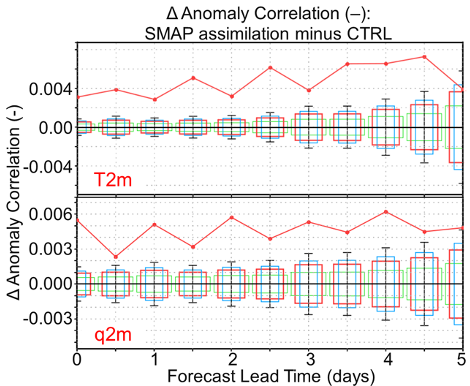SMAP Radiance Assimilation Over Land Improves GEOS Medium-Range Forecasts of Near-Surface Air Temperature and Humidity
Introduction
Soil moisture impacts evapotranspiration and, consequently, mediates the coupling between the land surface and the atmosphere under a range of conditions. Owing to the relatively slow time scale of soil moisture variations, the land surface is therefore a potential source of atmospheric predictability at medium-range to seasonal forecast lead times. This study demonstrates that the assimilation of brightness temperature (Tb) observations from the NASA Soil Moisture Active Passive (SMAP) mission in the Goddard Earth Observing System (GEOS) can improve medium-range forecasts of near-surface atmospheric conditions, compared to a system without SMAP assimilation.
Method
SMAP Tb observations were assimilated in GEOS using a weakly-coupled land surface analysis during June-August 2017, along with the assimilation of the standard suite of atmospheric observations in the hybrid four-dimensional ensemble-variational (Hybrid-4DEnVar) atmospheric analysis. For reference, a control (CTRL) experiment with atmospheric data assimilation but without SMAP Tb assimilation was also conducted. Daily forecasts out to 5-day lead time were initialized from the experiments with and without SMAP assimilation. The skill difference between the two sets of forecasts reflects the impact of the SMAP Tb assimilation.
Results
SMAP Tb assimilation significantly improves the skill of screen-level air temperature (T2m) and specific humidity (q2m) forecasts over global land out to lead times of 5 days, compared to forecasts initialized from the CTRL experiment (Figure 1).
The results demonstrate the potential of SMAP Tb observations for improving global operational weather analysis and forecasting systems.

References:
Reichle, R. H., S. Q. Zhang, J. Kolassa, Q. Liu, and R. Todling (2023), A Weakly-Coupled Land Surface Analysis With SMAP Radiance Assimilation Improves GEOS Medium-Range Forecasts of Near-Surface Air Temperature and Humidity, Quarterly Journal of the Royal Meteorological Society, in press, doi:10.1002/QJ.4486.


